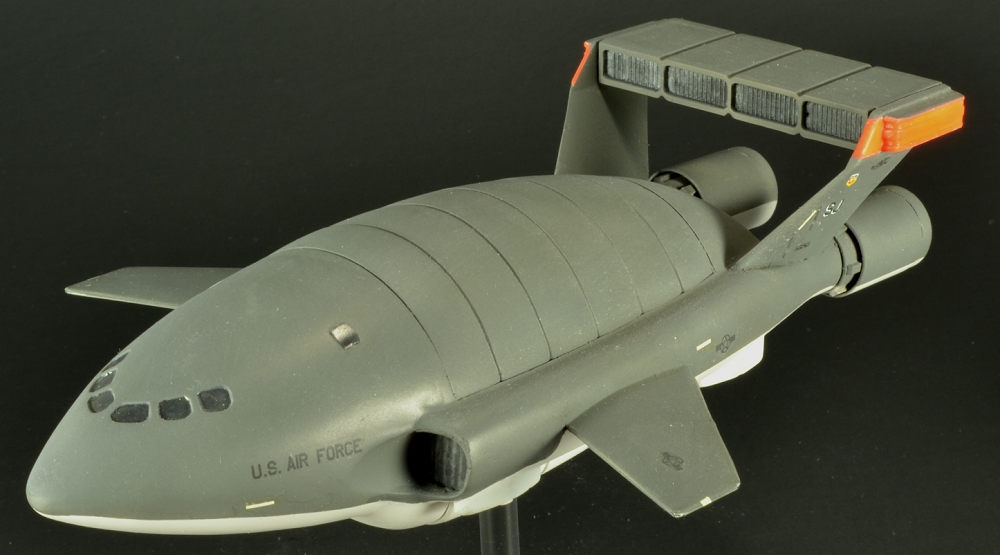
| KIT #: | ? |
| PRICE: | $10.00 'used' |
| DECALS: | One option |
| REVIEWER: | Ben Brown |
| NOTES: | This review landed on my hard drive after a wormhole to a parallel universe opened up near my wireless router. |

| HISTORY |
Thunderbird 2 (TB2) is one of
five vehicles operated by International Rescue, a disaster relief and rescue
organization based on billionaire astronaut Jeff Tracy’s formerly-hidden Tracy
Island (recently accidentally exposed by a certain well-known group when they
blundered into it during their continuing search for Amelia Earhart). The
monstrous lifting body cargo aircraft, 250 feet long and with a wingspan of 180
feet, can lift a heavy load off the ground using its vertical take-off/landing
(VTOL) thrusters, and then accelerate to its maximum speed of 5000 mph to
quickly fly non-stop to anywhere in the world. Its normal cruise speed is
usually a more sedate 2000 mph, unless when flying over populated areas, where
the flight usually remains subsonic. Cargo is carried inside a large pod that
forms the center of the fuselage. A
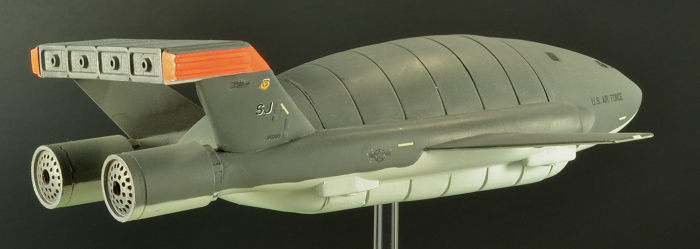 system of
hydraulic lifts raises TB2 high enough for the pods to be swapped in minutes.
Individual pods can be preloaded with cargo, various rescue vehicles, such as
The Mole (a high speed tunneling machine), firefighting equipment, recovery
vehicles, or Thunderbird 4, a small submarine for underwater rescue.
system of
hydraulic lifts raises TB2 high enough for the pods to be swapped in minutes.
Individual pods can be preloaded with cargo, various rescue vehicles, such as
The Mole (a high speed tunneling machine), firefighting equipment, recovery
vehicles, or Thunderbird 4, a small submarine for underwater rescue.
The need to replace the aging C-17 and KC-10 fleets led the USAF to issue a request for design submissions from industry leaders. Tracy Aerospace, a subsidiary of Tracy’s International Rescue, along with partner Lockheed, won the contract with a slightly smaller version of the highly successful TB2 design. Externally similar to TB2, the KC-65A Starlifter II (known as Bullfrog to its Western crews and Gamera to its Japanese crews) shares the hypersonic performance and global range of its bigger brother, and can even zoom climb to achieve earth orbit, thanks to recent improvements in engine and ultra-lightweight heat shield technologies.
Unlike the single-pilot Thunderbird 2, the KC-65A uses a standard crew of three: two pilots seated side-by-side and a loadmaster. The KC-65A also differs from TB2 in that the cockpit is equipped with side-stick controllers, electronic instrument panel displays, and throttles on a center console. Martin Baker Mk.26 escape capsules are provided for all three crew members and an observer position, and are certified for ejections at any speed or altitude within the aircraft’s performance envelope. Crew workload has been greatly reduced by the addition of Cyberdyne Systems’ new miniaturized artificial intelligence-based integrated autopilot and navigation systems. Upon suggestions from potential customers, the manufacturer dispensed with the Thunderbirds’ complicated machinations to get crews into position and the KC-65A’s crew use a simple ground-level hatch and interior ladder to get up to the cockpit.
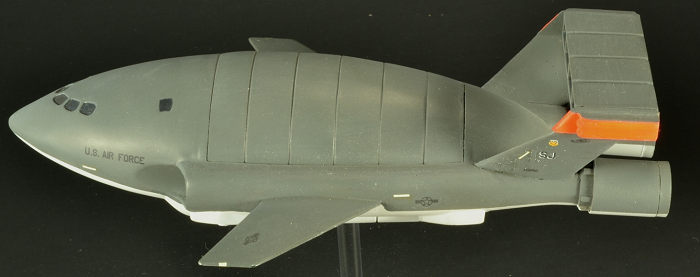 Cargo pods
can be quickly swapped, thanks to the hydraulic lift system pioneered by TB2. A
fuel pod, complete with an automated refueling probe, converts the KC-65A into a
tanker, while another enables the aircraft to be used for firefighting water
bomber duty. A specialized pod designed for low altitude cargo drops by way of
an updated version of the Low Altitude Parachute Extraction System (LAPES) used
by the old C-130 (still going, after three quarters of a century of service!),
allows payload delivery even at supersonic speeds (S-LAPES) for high-risk combat
situations. A troop-carrying version of the S-LAPES pod was proposed, but very
quickly rejected by everyone who would potentially be tasked to actually use it.
Cargo pods
can be quickly swapped, thanks to the hydraulic lift system pioneered by TB2. A
fuel pod, complete with an automated refueling probe, converts the KC-65A into a
tanker, while another enables the aircraft to be used for firefighting water
bomber duty. A specialized pod designed for low altitude cargo drops by way of
an updated version of the Low Altitude Parachute Extraction System (LAPES) used
by the old C-130 (still going, after three quarters of a century of service!),
allows payload delivery even at supersonic speeds (S-LAPES) for high-risk combat
situations. A troop-carrying version of the S-LAPES pod was proposed, but very
quickly rejected by everyone who would potentially be tasked to actually use it.
With its moderate size and relatively modest operating costs, the KC-65A has proven popular with foreign air forces, with purchases by the UK, Canada, Australia, Japan, and Germany. The KC-65A embodies everything NASA had once hoped the old space shuttle program could do, so they have purchased 10 C-65Bs (a light-weight civil version optimized for NASA’s mission) to supplement the fleet of commercial rockets used to supply the 2 International Space Stations and the orbital staging facility for the upcoming Mars mission.
The first KC-65As were delivered to the 4th Composite Wing’s 165th and 166th Air Transport Squadrons at Seymour Johnson AFB, and were declared fully operational 10 months later. They were immediately pressed into service as part of the massive air and sea bridge to California that was organized following The Big One, the great earthquake that broke the state away from the rest of the continent. The airlift was kept in operation until the first permanent bridges could be put in place almost a year later.
The squadrons also supported the Europe-wide effort to keep the British supplied for the three weeks it took to get power restored, when, in what amounted to an electrical perfect storm, every Lucas Electrical product in the country happened to actually work as it was intended to (or at least temporarily failed to short out) at exactly the same time, thus overloading the country’s electrical grid.
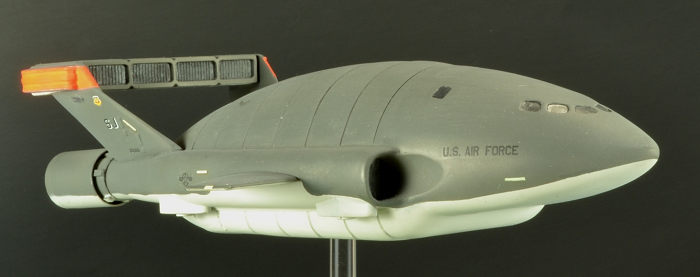 On the
other side of the world, Japan Self-Defense Forces KC-65As were instrumental in
transporting supplies to help repair damage in Tokyo after some local wildlife
waded through the buildings toward the center of town.
On the
other side of the world, Japan Self-Defense Forces KC-65As were instrumental in
transporting supplies to help repair damage in Tokyo after some local wildlife
waded through the buildings toward the center of town.
The KC-65A I chose to model is the well-known 25-0069, in honor of the enterprising 4th Wing crew who, during a food delivery for the California Airlift, single-handedly calmed the Vegan Riots with an impromptu S-LAPES drop, the resulting sonic boom and falling tofu and GMO-free granola almost instantly dispersing the hostile crowd. This was also the aircraft that was outfitted as a tanker to make the infamous beer run from a well-known US brewery to the UK during the Lucas Blackout. The reader will recall that this misguided attempt to show the British the merits of a cold American beer (and garner a certain congressman/brewery owner a lot of free advertising for both his beer and his upcoming reelection campaign) instead triggered a short diplomatic crisis when the British Prime Minister accused the US of trying to poison British citizens with tainted water. The conflict was finally resolved when the president personally called to assure the skeptical PM that the amber-tinted and mostly tasteless liquid in the tanker pod was indeed beer and that yes, it probably would have been better to have just popped by Dublin to pick up a few thousand kegs of Guinness. The ex-congressman is still serving time in Federal prison for campaign fraud and misuse of military assets.
| THE KIT |
[According to several Internet sources, the Aoshima 1/350 and the Konami 1/700 TB2 kits are considered to be the most accurate. As this was to be just a fun project, I skipped “accurate” and went straight to “cheap.”]
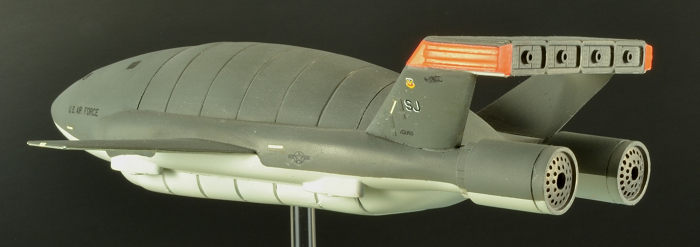 The kit is
molded in green plastic, with a second sprue in red plastic. A small decal sheet
with the yellow strips and “T2” logos that adorned the original TB2 is provided,
along with a wind-up motor and the familiar tiny tube of glue that one often
finds in old Japanese model kits. The cargo pod is removable, and includes three
little elevator vehicles that supposedly will roll out of the pod when the ramp
is lowered. The more likely scenario would be the first vehicle would get hung
up in the opening, causing the other two to pile up behind it and jam the pod
ramp open. The TB2 is made up of 10 parts (11 if you use the ramp on the pod),
and the rest of the parts in the box are used to build the vehicles.
The kit is
molded in green plastic, with a second sprue in red plastic. A small decal sheet
with the yellow strips and “T2” logos that adorned the original TB2 is provided,
along with a wind-up motor and the familiar tiny tube of glue that one often
finds in old Japanese model kits. The cargo pod is removable, and includes three
little elevator vehicles that supposedly will roll out of the pod when the ramp
is lowered. The more likely scenario would be the first vehicle would get hung
up in the opening, causing the other two to pile up behind it and jam the pod
ramp open. The TB2 is made up of 10 parts (11 if you use the ramp on the pod),
and the rest of the parts in the box are used to build the vehicles.
| CONSTRUCTION |
The Bandai kit has a few spots that could use improvement, merely because the model was simplified for easier assembly. There is a nasty seam that runs right through the intakes, and it was easier to just make new ducts with some rolled-up styrene sheet and add new intake screens than to try to fill the seams and salvage the kit’s intake screens. While I had the styrene sheet out, I filled the holes for the friction motor’s wheels. There is a large, round hole in the middle of the cargo pod that was a perfect size for a section of brass tube for setting the model on a display stand. I glued the tube in place with epoxy.
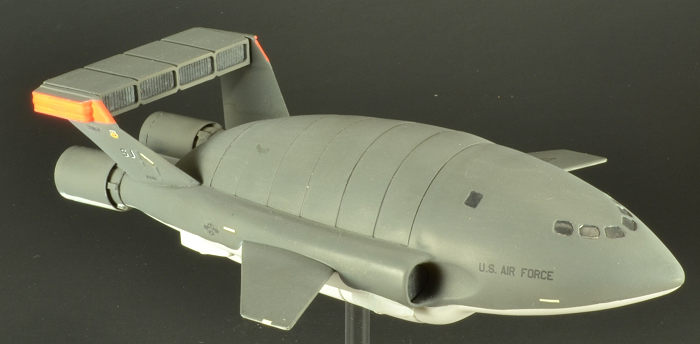 The
assembled cargo pod fits into the fuselage fairly well, although it required
some sanding to match the curvature of the fuselage. The fuselage booms that
make up the intake ducts on the fuselage sides also house hydraulic lifts. The
fairings for the lifts have some dimples that must be filled. I punched out 4
styrene discs and used them to cover the holes where the extended jack tubes
plug into the fairings.
The
assembled cargo pod fits into the fuselage fairly well, although it required
some sanding to match the curvature of the fuselage. The fuselage booms that
make up the intake ducts on the fuselage sides also house hydraulic lifts. The
fairings for the lifts have some dimples that must be filled. I punched out 4
styrene discs and used them to cover the holes where the extended jack tubes
plug into the fairings.
In spite of my best efforts to keep Scope Creep under control, I ended up replacing the kit’s exhaust nozzles with brass tube and styrene. I would have left them alone, but it was easier to just make new ones than to clean up the kit nozzles’ soft red plastic. I cut off the aft ends of the kit nozzles and glued them to the larger tube, then slipped that tube over some styrene vanes glued to the smaller sections of tube.
There are several indentions around the model, such as a large boarding hatch on top of the fuselage for TB2’s single pilot, which are not present on the KC-65A, so I filled them with styrene.
| COLORS & MARKINGS |
 Since
KC-65As are combat aircraft, they don’t have the bright red and yellow markings
seen on TB2. The only bright colors are the 165th’s
and 166th’s fluorescent red and
fluorescent green tail bands. I painted the model in the standard “Shamu”
camouflage colors of Europe 1 Gray over Light Gray, using Model Master Canadian
Voodoo Gray as a substitute for the in-house light gray used at the factory. I
painted the Day-Glo orange tail bands by first spraying a coat of Tamiya white
primer, followed by several light layers of Model Master fluorescent red.
Since
KC-65As are combat aircraft, they don’t have the bright red and yellow markings
seen on TB2. The only bright colors are the 165th’s
and 166th’s fluorescent red and
fluorescent green tail bands. I painted the model in the standard “Shamu”
camouflage colors of Europe 1 Gray over Light Gray, using Model Master Canadian
Voodoo Gray as a substitute for the in-house light gray used at the factory. I
painted the Day-Glo orange tail bands by first spraying a coat of Tamiya white
primer, followed by several light layers of Model Master fluorescent red.
I drew up the various markings, including the 4th’s Wright Flyer tail logo, using Inkscape, and printed them on clear decal film with a laser printer. The formation lights, tail codes, and a few other odds and ends came from the decal scrap box.
There wasn’t much to add during the final assembly process, since all antennae and beacons on the aircraft are flush-mounted to the skin. I painted a wood plaque flat black and added an acrylic rod, which fit inside the brass tube in the cargo pod.
| CONCLUSIONS |
A fun model of a very interesting aircraft. Even though it has only been in service for a few years, it looks like the KC-65 series is going to have a long and very colorful career. Finally, I’d like to join everyone in wishing Modeling Madness owner Da Boss a speedy recovery from the injuries he sustained while building one of those new heavily-armed, fully mobile, self-aware female anime figures. Remember folks, there is a very good reason they put that large, red-letter warning on Page 1 of the instructions, reminding builders to warm the paint before attempting to paint the figure’s [CENSORED]. Thank you, Ben. There are times when motor-boating can be dangerous. Ed
| REFERENCES |
“Air Force Attacks Peaceful Protesters with Non-Organic Food, Sonic Boom,” San Francisco Chronicle, November 22, 2026.
“PM: Keep calm, the Yanks are not trying to poison us!” London Times, 13 January 2027.
“Air Force Crew Cleared of Wrongdoing, Cited as Heroes in California ‘Tofu Bombing’ Incident,” New York Times, January 20, 2027.
“JSDF KC-65s Play Key Role in Tokyo Relief Efforts after Monster Attack,” Tokyo Shimbun, 28 March, 2027.
The Official History of the International Rescue Thunderbirds. Scott Tracy, 2025.
Wikipedia
12 March 2018
Copyright ModelingMadness.com If you would like your product reviewed fairly and fairly quickly, please
contact the editor
or see other details in the
Note to
Contributors.
Back to the Main Page
Back to the Review
Index Page
Back to the Previews Index Page